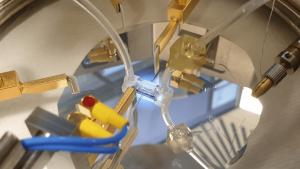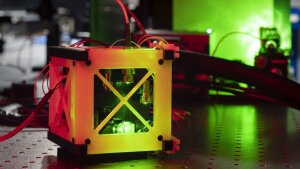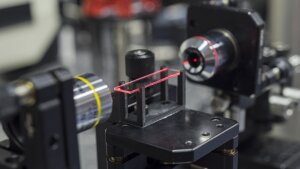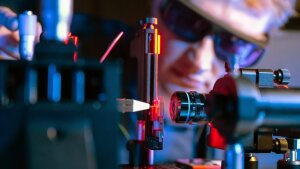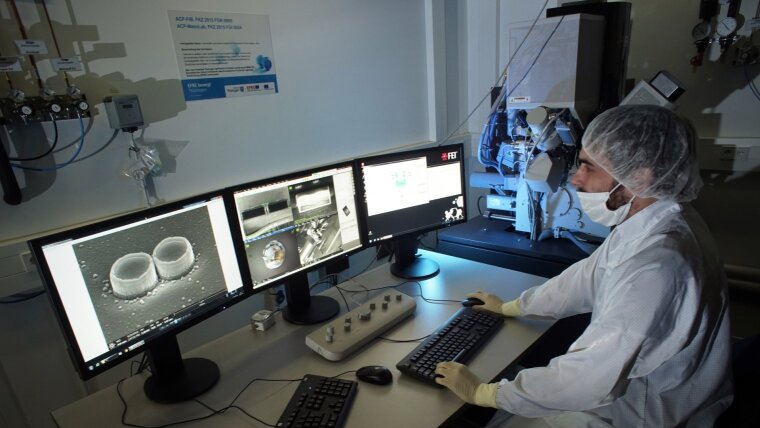
The Thuringian Innovation Center InQuoSens was supported in its first funding phase (2017-2022) by the Thuringian State (2017 IZN 0012) and the European Regional Development Fund (EFRE).
Moreover, the following Thuringian research groups were embedded in InQuoSens during this phase.
InQuoSens-embedded research groups 2017-2022
Scanning electron microscope inspection.
Image: Jan-Peter Kasper (University of Jena)FOQUOS – Thuringian Research Group for imaging with entangled photons (2018-2021)
The aim of FOQUOS was the fundamental investigation of imaging modalities based on the peculiar properties of entangled photons. As a result, application perspectives for quantum imaging schemes and a roadmap for further development were established. The research was pursued along two complementary lines reflecting the strengths of the project partners in Jena and Ilmenau. First, quantum imaging schemes and the necessary photon sources were examined to identify conceptually new modalities, with a particular focus on making use of photon pairs with different wavelengths. Second, concepts to realize electronic components suited to implement and integrate the needed photon detection and analysis schemes were developed. The results of both research lines were be used to realize first demonstrators of quantum imaging schemes.
FOQUOS was supported by the Thuringian State (2017 FGR 0067) and the European Social Fund (ESF) with EUR 695,000 in 2018-2021.
Development of highly sensitive sensors based on 2D materials
Image: Beate Hoevelmans, IMMS Erfurt2D-SENS – Thuringian Research Group for ultrasensitive energy-efficient gas sensors from 2D materials (2019-2022)
2D-materials are ideal for nanoscale and quantum sensing applications. Consisting almost completely of surface, they interact strongly with many aspects of the environment. Their strong light-matter interaction also allows for the remote readout of their status with comparable ease. Of interest are materials of the semi-conductiong group of 2D Transition Metal Dichalcogenides (TMDs) like like molybdenum disulfide (MoS2) or tungsten disulphide (WS2). Within the 2D-SENS group, the researchers aimed to use the properties specifically for gas sensors and developed four different types based on the TMDs. These integrated 2D-materials were investigated concerning fundamental aspects of how the environment influences the light-matter-interaction in 2D-materials, regarding fluorescence lifetimes, spectra and valley-excitonic properties.
2D-Sens was supported by the Thuringian State (2018 FGR 0088) and the European Social Fund (ESF) with EUR 650,000 in 2019-2022.
Single-photon source for secure quantum communication.
Image: Tobias Vogl, ANU CanberraFASTPHOTON – Thuringian Research Group for single-photon laser-diodes in quantum communication (2020-2022)
Quantum physical phenomena enable novel applications in science and technology that lead to significant improvements in information processing. In particular, quantum communication is already technologically mature for real application scenarios. By means of Quantum Key Distribution (QKD), it is possible to drastically increase data security in new digital business fields such as smart grids, personalized medicine or microtransaction banking. Thus, quantum-based, secure communication will on short-term become the locational advantage of a data-driven economy. However and so far, many quantum communication scenarios achieve only low electro-optical integration density and key rates in the low kbit range. The overall goal of the research group FastPhoton was to advance quantum communication by focussing on the high-frequency control of photon sources in high-performance opto-electronic components and assemblies. The research group targeted applications of optical, quantum-based data communication in fiber optical and and satellite networks.
FastPhoton was supported by the Thuringian State (2019 FGR 0101) and the European Social Fund (ESF) with EUR 650,000 in 2020-2022.
Integrated optical waveguide for quantum applications.
Image: Jan-Peter Kasper (University of Jena)E-PhoQuant – Thuringian Research Group for heterogeneous electronics-photonics integration in quantum-photonic components (2021-2022)
The application of quantum physical phenomena holds solid promise to revolutionize the transmission and processing of information with regard to data security. Research in the field of tap-proof encryption using Quantum Key Distribution (QKD) is pioneering this. The necessary communication technology basics for increasing the key transmission rates were developed within the framework of this research group. Our research goals included increasing the control frequencies of photon sources, reducing the transmission losses of quantum mechanical states and improving the time resolution of detectors. The focus of the research was not only on their miniaturized integration as a basis for acceptance in e.g. mobile systems. As part of the research, a heterogeneous integration solution for the realization of compact quantum optical components and modules and their fabrication on wafer-scale level was also developed.
E-PhoQuant was supported by the Thuringian State (2020 FGR 0048) and the European Social Fund (ESF) with EUR 470,000 in 2021-2022.
Research infrastructure attached to InQuoSens
Adjustment of an optical chip with a quantum light source.
Image: Jens Meyer (University of Jena)ThürQuant – Research on quantum optics and sensors for sustainable and safe information technology in Thuringia
With the ThürQuant project, a quantum processor was installed at the Jena site, which at this time represented a significant thematic addition to the existing Thuringian innovation center InQuoSens. The processing of quantum light in an interferometric setup is a fundamental basic scientific basis for the processing of quantum information, which is foreseen to be included in a quantum network on the national scale.
ThürQant was supported by the Thuringian State (FKZ 2022 IZN 0007) and the European Regional Development Fund (EFRE) with up to EUR 312,500 in 2022-2023.
